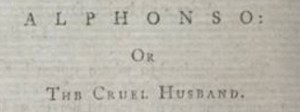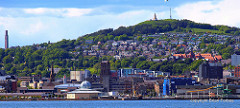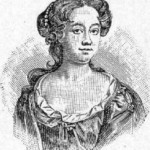We are approaching that time of the year again. Every year from spring to late summer, Conference Season brings opportunities to learn about the research of colleagues working all over the world, to see old friends, and to meet new ones. This festive period lasts longer than Christmas time, and in many ways, it’s better. You get to talk freely about your obsessions without relatives and friends diverting the conversation to less esoteric subjects, and who doesn’t like a good wine reception? At the bottom of this post you will find a calendar of conferences and workshops which will be attended by Team Lady’s Mag in the near future, but in this blog post I will zoom in on an early event that I have been particularly looking forward to: this week’s Authorship & Appropriation conference at the University of Dundee (8 – 9 April 2016).
As we have been telling you from our first post, gaining insight into the authorship of the Lady’s Magazine is a major goal of our research project. We soon found that the myriads of reader-contributors who supplied the bulk of the magazine’s contents did not just submit original productions, but also acted as intermediates who disseminated the work of others. Often, their submissions elaborated on or were downright identical to previously published texts by other authors; in other words, they engaged in appropriation. We were therefore very excited when we read in the CFP for this event that papers were invited on the “theory and practice of the adaptation and appropriation of literary texts”. Jenny DiPlacidi and I proposed a panel on ‘Appropriation as Cultural Transmission in the Eighteenth-Century Periodical Press’, which was lucky enough to be accepted. Ours is session 3C on Friday afternoon, in case you’re around and would like to join us! Jenny and I will of course be talking about the Lady’s Magazine (when are we not?), but this isn’t strictly a Lady’s Mag panel. Jennie Batchelor will unfortunately not be able to join us, but we were very happy to find a third speaker in our Kent colleague Dr Kim Simpson (@AmatoryAnon). Kim works on anonymity and appropriation in early eighteenth-century prose fiction, and has recently been exploring the afterlives of these narratives in mid-century periodicals. We expect that the three of us together will be able to do justice to the central role in literary history of appropriations from and in eighteenth-century periodicals.
Most readers of this blog will know that periodicals were the primary site of literary publication throughout the eighteenth century. The number of authors who made it to the stage of getting their own books published was dwarfed by the myriads of those contributing essays, verse and short or serial fiction to the essay papers, newspapers and magazines of their day. Encouraged by a more lenient attitude towards intellectual property, and a smaller risk of prosecution due to less stringent copyright laws, magazines in particular liberally repurposed material from other sources such as books and competing periodical titles. This practice was often justified at the time as a form of cultural transmission: in the spirit of the Statute of Anne that limited the ownership of copyright to a limited period so that texts could later circulate freely, periodicals would have disseminated meritorious literary productions so a wider readership could benefit. In this period the distinction between repurposed content and original copy is problematic, because appropriated texts were often subtly adapted and subsequently with no qualms claimed by the author-appropriators as their own. The three papers in this panel discuss instances of how this practice of appropriation in British eighteenth-century periodicals contributed to the development and popularization of certain literary modes, themes and genres, either reading long-forgotten original publications from periodicals as possible models for now canonized texts, or, conversely, demonstrating how the legacy of famous texts was kept alive in periodicals through unacknowledged adaptations written by minor authors.
Jenny DiPlacidi: ‘“Full of pretty stories”: Literary Afterlives in the First Series of the Lady’s Magazine’

LM, V (Aug 1774): 182. Image © Adam Matthew Digital / Birmingham Central Library. Not to be reproduced without permission.
This paper examines appearance and reuse of Gothic conventions in the fiction of the Lady’s Magazine: or, Entertaining Companion for the Fair Sex (1770-1832), analysing the fiction’s engagement with earlier texts and assessing its influences on later and better-known works. It argues against the critical tradition that has long disparaged the periodical’s tales as derivative works produced by amateurs to suggest that its fiction was a significant cultural form that reworked classical and contemporary tales to establish and shape eighteenth-century popular literature. For example, the short tale ‘Alphonso; or, The Cruel Husband’ (1774) reframes Boccaccio’s story of Ghismonda and Guiscardo, popularized by Hogarth’s 1759 painting, and, arguably, participates in a cultural practice in which classical works were marketed and consumed via translations later reformulated within the magazine. The History of an Humble Friend (1774-76), an anonymous serial novella, shares marked similarities to Frances Burney’s Evelina (1778) and Ann Radcliffe’s The Italian (1797). The serial deploys standard eighteenth-century Gothic tropes such as the reclamation of the missing mother early on in traditional chronologies of the genre. Likewise, its presentation of the sentimental orphan prefigures later representations in novels by Burney and Charlotte Smith. Stories like this, The Governess (1778-80) and The History of Lady Bradley (1776-78) are preoccupied with issues such as women’s education, laws, marriage and inheritance and the conflict between duty to family and self-autonomy; concerns central to eighteenth-century society that featured prominently – and similarly – in later canonical texts.
Kim Simpson: “Anomalous & Anonymous: Locating Links and Chasing Tales in Amatory Fiction and Beyond”
In 1723, Jane Barker, writing as Galesia in A Patch-Work Screen for the Ladies, spoke indignantly and scornfully of Aphra Behn, despite, in the 1726 sequel, The Lining of the Patch Work Screen, borrowing from her short fiction plots for inset narratives. One of these borrowings was from Behn’s ‘The Wand’ring Beauty’ (1698). Although Carol Shiner Wilson, amongst others, have noted this particular reworking, in 1723 the text had undergone another adaptation by the little-known Arthur Blackamore, which was crucial to Barker’s version. Reading these three versions together, this paper traces and analyses the transformations of the original plot. It contends that Blackamore’s rendering develops the disguised amatory heroine, foreshadowing later works that address proto-feminist strategies of dissimulation. Meanwhile, Barker’s self-conscious positioning of Behn’s romance tale alongside the inset narrative ‘The History of Dorinda,’ a reactionary warning about the dangers of quixotic reading practices, prefigures Charlotte Lennox’s The Female Quixote (1752), as well as some of the concerns articulated by Eliza Haywood in her periodical the Female Spectator (1744-46). This case study explores the complex and contradictory ways in which the generative potential of the original was exploited by subsequent writers. It maps out influence between amatory writers, between early and mid-century writers, and between short fiction and the periodical. But it also makes a claim for the importance of lesser known and anonymous writers in this time period, demonstrating that despite our tendency to place known authors at the centre of study, a fuller picture of the array of understudied texts might demonstrate that they shaped and informed attributed ones as much as the other way around.
Koenraad Claes: “Poetics of appropriation: re-occasioned occasional verse in the Lady’s Magazine”
The Lady’s Magazine (1770-1832) stands out among periodicals of the late eighteenth and early nineteenth century because of the exceptionally large extent to which it relied on readers’ submissions for its copy. According to the scholarly consensus, the early years of this periodical coincided with the breakthrough of sentimental verse, and much of the poetry submitted by readers does adhere to what Jerome McGann has identified as ‘the poetics of Sensibility’: featuring a strong emphasis on the recording and communication of an individual’s ‘affects’, i.e. emotional responses to specific situations. Most of the poetry submitted by the readers to the magazine belongs to the subgenre of ‘occasional verse’, usually short lyrical poems that were meant to mark a specific event that had impressed the poet. However, research by the Lady’s Magazine Project has shown that most of these poems were not merely influenced by the leading poets of Sensibility of the period, but are undeniably appropriations. These appropriations often are near-verbatim copies of famous or more obscure originals in which only references to the absolute specifics of settings or addressees were altered. This paper will discuss how such loose notions of intellectual property could coexist with the valuation of emotional authenticity that is apparent from the poems themselves and from the reception of other work in this genre, and will identify which specific aspects of appropriated texts were adapted to detach the source text from its original author and publication context.
We would love to meet our readers attending the conference in Dundee, so if you are around, please do come say hello. Alternatively, this spring and early summer you will be able to hear us at the following events.
13 May – University of East Anglia (Norwich) – CHASE workshop “Periodical Studies”
17 May – Cardiff University – Cardiff Romanticism and Eighteenth-Century Seminar: CRECS Annual Conference
7-8 July – Liverpool John Moores University – European Society for Periodical Research (ESPRit): Conf. Periodical Counter Cultures
15 July – Athenaeum Club (London) – Conf. Victorian Periodicals Through Glass


